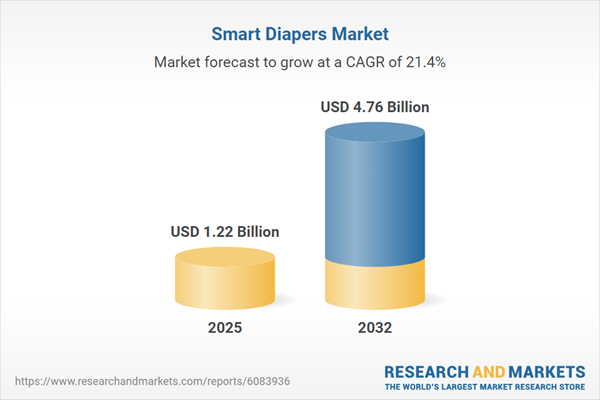Speak directly to the analyst to clarify any post sales queries you may have.
The Smart Diapers Market is undergoing rapid evolution, driven by new sensor-driven hygiene solutions that improve care delivery, enhance operational processes, and align with digital health initiatives. As next-generation products become integrated across healthcare and home care settings, senior leaders are positioned to advance both service quality and organizational efficiency.
Market Snapshot: Smart Diapers Market Growth
In 2024, the global Smart Diapers Market is valued at USD 1.01 billion and is projected to reach USD 1.22 billion in 2025, expanding at a CAGR of 21.37%. This robust progression reflects the interplay of demographic dynamics, including an increasing elderly population and heightened neonatal care requirements. The proliferation of sensor-enhanced hygiene innovations, especially in hospital and home-care environments, underscores a clear trend toward digitally connected monitoring and the pursuit of higher standards in patient care. The convergence of aging populations and an emphasis on neonatal wellbeing pave the way for strong adoption and persistent demand for intelligent hygiene solutions in both developed and emerging regions.
Scope & Segmentation of the Smart Diapers Market
The Smart Diapers Market offers granular segmentation that supports strategic planning and data-driven investment decisions for healthcare providers, product developers, and distributors. The segmentation encompasses the full breadth of product, technology, delivery, and end-user needs.
- Product Types: Disposable options classified by premium and standard tiers, as well as reusable models including silicone insert and washable formats that respond to sustainability goals and varying use cases.
- Technologies: Leak detection, multi-sensor platforms (comprising temperature, wetness, and motion capabilities), dedicated temperature sensors, and wetness sensors, each enabling more tailored responses and care interventions.
- Distribution Channels: Hospitals serving both elderly and neonatal populations, online platforms (company websites and e-commerce marketplaces), and retail channels spanning hypermarkets, supermarkets, pharmacies, and specialty stores, ensuring comprehensive product reach.
- End Users: Solutions catering to adult seniors, infants, and toddlers, with customization supporting diverse care needs and clinical protocols.
- Connectivity Types: Integration with Bluetooth (BLE, Classic), NFC, and Wi-Fi (802.11ac/ax, 802.11b/g/n), optimizing compatibility with telehealth and remote monitoring ecosystems.
- Sales Models: Single-use purchases and subscription arrangements (annual, monthly, quarterly) permit flexible alignment with organizational budgets and user demand.
- Regions: Comprehensive coverage across the Americas, Europe, Middle East, Africa, and Asia-Pacific, featuring primary and emerging markets such as the United States, Germany, Japan, and Brazil.
- Key Companies: Well-established manufacturers and innovators such as Kimberly-Clark Corporation, Procter & Gamble Company, Essity Aktiebolag (publ), Ontex Group NV, Unicharm Corporation, Kao Corporation, Hengan International Group Company Limited, and Dryad Diapers Ltd.
Key Takeaways for Decision-Makers
- Adoption of smart diapers is fueled by growing expectations for outcome-based care, particularly in hospital and home settings where both comfort and workflow efficiency are paramount.
- Sensor technology generates real-time, actionable data, empowering earlier care interventions that can minimize risk of skin complications and reduce the rate of unnecessary readmissions.
- Direct integration with telehealth infrastructure through Bluetooth, NFC, and Wi-Fi allows remote monitoring and immediate data transfer, enhancing clinical oversight without increasing burden on staff.
- Versatile sales models, including both single-use and recurring subscriptions, support cost-effective procurement and scalable deployment, accommodating fluctuating organizational needs.
- Collaborative ventures between principal industry participants and technology developers are advancing analytics capabilities and expanding the reach of multi-sensor hygiene platforms.
- Distinct regulatory frameworks and infrastructure maturity across global regions create both expansion opportunities and operational complexities, requiring strategic navigation by market entrants and established players.
Tariff Impact: Navigating Cost Pressures and Supply Chain Shifts
Impending United States tariffs on imported smart diapers and components in 2025 are contributing to increasing supply chain intricacies. To sustain profitability and consistent product availability, manufacturers are relocating certain assembly tasks to domestic sites, building new supplier partnerships, and modifying packaging and pricing structures. These adaptations address extended logistics timelines and mitigate rising costs, emphasizing the value of agile supply chain management and close collaboration among procurement, manufacturing, and distribution teams. Effective response to these tariff-induced developments is critical for maintaining stable market access.
Methodology & Data Sources
This analysis leverages a hybrid approach, combining firsthand interviews with clinical practitioners and caregivers, extensive secondary research, and examination of real-world device data. Workshops with product developers and material scientists inform qualitative insights, while benchmarking and scenario stress-testing reinforce the validity and practical relevance of the findings.
Why This Report Matters
- Empowers senior leaders to identify growth opportunities and refine strategies for engaging target market segments in the evolving smart diaper sector.
- Delivers a practical analytical base for investment prioritization, channel development, and operational planning in view of changing regulations and tariff landscapes.
- Clarifies pathways for effective partnerships, differentiation, and technology adoption that support long-term market success.
Conclusion
The Smart Diapers Market is setting a new standard for digital hygiene and connected care. Strategic adoption of technology, proactive regulatory navigation, and collaboration will drive value and advancement across health delivery ecosystems.
Table of Contents
3. Executive Summary
4. Market Overview
7. Cumulative Impact of Artificial Intelligence 2025
Companies Mentioned
The companies profiled in this Smart Diapers market report include:- Kimberly-Clark Corporation
- Procter & Gamble Company
- Essity Aktiebolag (publ)
- Ontex Group NV
- Unicharm Corporation
- Kao Corporation
- Hengan International Group Company Limited
- Dryad Diapers Ltd.
Table Information
| Report Attribute | Details |
|---|---|
| No. of Pages | 188 |
| Published | October 2025 |
| Forecast Period | 2025 - 2032 |
| Estimated Market Value ( USD | $ 1.22 Billion |
| Forecasted Market Value ( USD | $ 4.76 Billion |
| Compound Annual Growth Rate | 21.3% |
| Regions Covered | Global |
| No. of Companies Mentioned | 9 |









